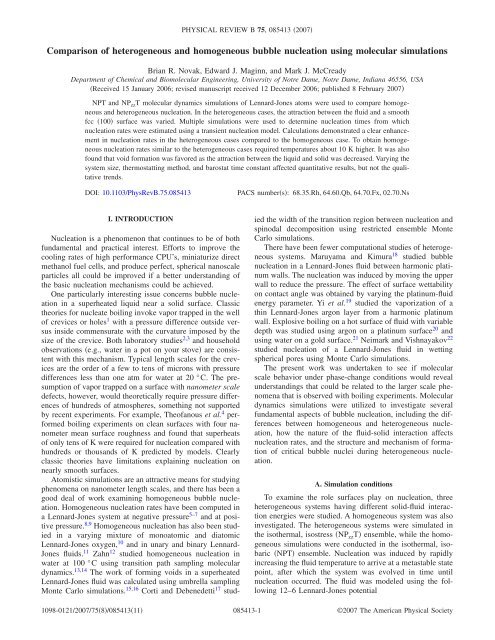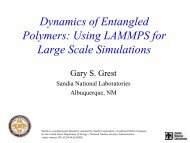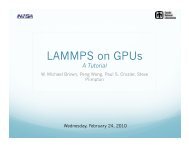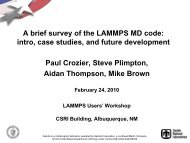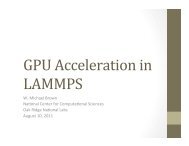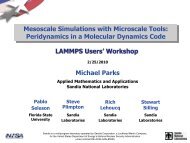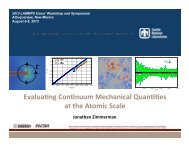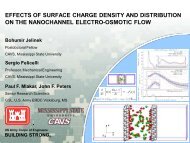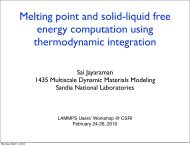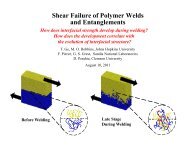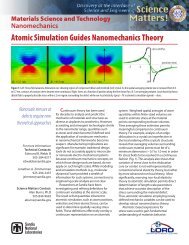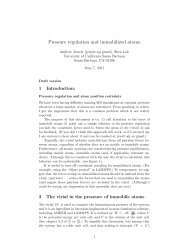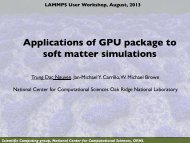Comparison of heterogeneous and homogeneous bubble nucleation ...
Comparison of heterogeneous and homogeneous bubble nucleation ...
Comparison of heterogeneous and homogeneous bubble nucleation ...
Create successful ePaper yourself
Turn your PDF publications into a flip-book with our unique Google optimized e-Paper software.
NOVAK, MAGINN, AND MCCREADYPHYSICAL REVIEW B 75, 085413 2007FIG. 5. Volume as a function <strong>of</strong> time for the weak <strong>and</strong> <strong>homogeneous</strong>cases. Open symbols are the points at the <strong>nucleation</strong> time.Filled symbols are the volumes used to calculate the averagevolume.The differences in <strong>nucleation</strong> rates between the <strong>heterogeneous</strong>systems were correlated with the strength <strong>of</strong> interactionbetween the fluid <strong>and</strong> the solid, <strong>and</strong> consequently withthe ordering near the <strong>nucleation</strong> site. Making the surfacemore attractive decreased the <strong>nucleation</strong> rates, but there wasa limit to this. Once the interactions were strong enough toinduce solidlike order <strong>of</strong> the fluid near the surface, furtherincreasing the interaction energy had little effect on <strong>nucleation</strong>rates. Thus the strong <strong>and</strong> neutral surfaces had similar<strong>nucleation</strong> rates, while the weak case had much higher ratesat the same temperature.Changing the threshold volume used to determine the<strong>nucleation</strong> times in the <strong>heterogeneous</strong> cases from 15 to 30%above the average volume usually increased the <strong>nucleation</strong>rate. As shown in Table III, the average increase was 37.5%in the weak case. In the neutral case, the average increasewas 26.1%, while in the strong case the average change was9.3%. In the neutral <strong>and</strong> strong case the <strong>nucleation</strong> rate decreasedfor the lowest <strong>and</strong> two lowest temperatures, respectively.In these cases the increase in <strong>nucleation</strong> rate also becamelarger with increasing temperature.FIG. 6. Number density pr<strong>of</strong>iles for the three <strong>heterogeneous</strong>cases at the initial state point 96.0 K. The first four peaks are thesolid layers <strong>and</strong> the other peaks are fluid. All three cases show someordering near the solid surface. There is also some ordering at largez due to the top wall potential. The more attractive surfaces showmore ordering <strong>and</strong> this ordering extends further into the liquid.FIG. 7. Nucleation times vs the negative logarithm <strong>of</strong> the ratio<strong>of</strong> the number <strong>of</strong> nonnucleated simulations to the total number <strong>of</strong>simulations. The symbols are simulation results for the neutral case<strong>and</strong> lines are the fit to Eq. 7. The temperatures in the legend arethe set point temperatures.When controlling the temperature <strong>of</strong> the solid <strong>and</strong> fluidseparately, <strong>nucleation</strong> rates increased by up to a factor <strong>of</strong>four with the largest difference at the highest temperature.This was probably due to the increasing difference in fluidtemperature compared to set point temperature as seen inFig. 2. Time lags t 0 were essentially unchanged. The netresult was that, while differences in thermostatting methoddid affect the actual values obtained for the <strong>nucleation</strong> rate, itdid not appear to qualitatively change the basic finding thatthe presence <strong>of</strong> even a smooth surface with no solid or fluidimpurities greatly enhances <strong>nucleation</strong> rates when comparedTABLE III. <strong>Comparison</strong> <strong>of</strong> steady state <strong>nucleation</strong> ratesm −3 s −1 10 −35 for the one thermostat <strong>heterogeneous</strong> cases whenthe <strong>nucleation</strong> times were at 1.15 times the average volume or 1.3times the average volume. Estimated fluid temperatures T fl as wellas set point temperatures T set are shown. Numbers in parenthesesare the 68.3% confidence intervals.T set K T fl K J s 1.15 J s 1.3Weak132.0 130.30 0.250.182, 0.360 0.290.218,0.431133.0 130.41 0.60.44, 0.88 0.90.67,1.3134.0 130.25 42.7, 5.4 53.7,7.0135.0 130.82 75.0, 9.9 96.4,12135.5 131.00 85.9, 12.3 107.38,15.1136.0 131.21 53.5, 7.1 75.6,11Neutral134.0 133.57 0.0120.0081, 0.0192 0.0120.0082,0.0180135.0 134.17 0.100.072, 0.149 0.100.0726,0.149135.5 134.46 0.40.25, 0.54 0.60.40,0.88136.0 134.81 1.81.29, 2.70 2.51.79,3.90Strong134.5 134.05 0.0170.0116, 0.0276 0.0160.0116,0.0255135.0 134.41 0.050.035, 0.076 0.050.035,0.073135.5 134.67 0.180.122, 0.291 0.190.135,0.295136.0 134.95 0.50.39, 0.83 0.70.49,1.1085413-6
COMPARISON OF HETEROGENEOUS AND HOMOGENEOUS…PHYSICAL REVIEW B 75, 085413 2007TABLE IV. Free energies kJ/mol nuclei, pre-exponential factorsm −3 s −1 <strong>and</strong> steady state <strong>nucleation</strong> rates m −3 s −1 10 −35 from the classical theory at the temperatures used in the <strong>homogeneous</strong>case.Temperature K143.5 143.7 144.0 144.5G 12.11 11.35 10.25 8.6535ln A 90.59 90.56 90.55 90.50J s 0.8584 1.605 4.036 15.00FIG. 8. Steady state <strong>nucleation</strong> rate J s vs 1/T for all cases. Errorbars are the 68.3% confidence intervals. The weak case data shownare for two thermostats. For the neutral <strong>and</strong> strong cases, the solidsymbols are using the fluid temperature instead <strong>of</strong> set point temperatureopen symbols. The line is the classical <strong>nucleation</strong> theoryresult for the same temperatures as the <strong>homogeneous</strong> case.to <strong>homogeneous</strong> <strong>nucleation</strong>. Furthermore, the weakly attractivesurface induces <strong>nucleation</strong> much more readily than aneutral or strongly attractive surface.C. Temperature dependence <strong>of</strong> <strong>nucleation</strong> rate <strong>and</strong>comparison to classical <strong>nucleation</strong> theoryThe <strong>nucleation</strong> rate as a function <strong>of</strong> inverse temperature isplotted in Fig. 8 for all cases. The solid <strong>and</strong> fluid were independentlythermostatted for the weak case. For the strong<strong>and</strong> neutral cases, <strong>nucleation</strong> rates are shown using both theset point <strong>and</strong> fluid temparatures.Nucleation is an activated process, so the steady state<strong>nucleation</strong> rate should be related to the free energy changefor <strong>nucleation</strong> via an Arrhenius-type expression,lnJ s =lnA − Gk B T .8Although the data in Fig. 8 appear to be reasonably linear,both the pre-exponential factor A <strong>and</strong> free energy changeG are functions <strong>of</strong> temperature. For this reason, it was notpossible to estimate reasonable free energy activation barriers.However, it is possible to compare the <strong>homogeneous</strong>simulation results with classical <strong>nucleation</strong> theory. The classicaltheory gives the <strong>nucleation</strong> rate for a superheated singlecomponent system as follows: 37J s = l 3 lv1/2mexp−16 lv33k B T l P sat − P l 2, = exp P l − P sat. 9 l k B T lThe <strong>nucleation</strong> rate depends on the number density <strong>of</strong> theliquid l , liquid-vapor surface tension lv , mass <strong>of</strong> a moleculem, temperature T l , saturation pressure P sat , <strong>and</strong>liquid pressure P l . The saturation pressure was calculatedusing the Lennard-Jones equation <strong>of</strong> state. 28 The followingexperimental correlation for the temperature dependence <strong>of</strong>the liquid-vapor surface tension for argon was used Ref.38, lv = 3.823 10 −21− T T c1.2927,T c = 158.9K,10where T c is the Lennard-Jones critical temperature used byJohnson et al. 28 The number density <strong>of</strong> the liquid was calculatedfrom the volumes obtained from the simulations. Thefree energy change is given byG =<strong>and</strong> the critical radius is316 lv3P sat − P l 2 ,112 lvr crit = .12P sat − P lUsing Eqs. 9 <strong>and</strong> 11, the <strong>nucleation</strong> rates <strong>and</strong> free energieswere calculated at the temperatures used in the simulations.The classical <strong>homogeneous</strong> <strong>nucleation</strong> rates, free energychanges, <strong>and</strong> pre-exponential factors obtained from Eq. 9are shown in Table IV <strong>and</strong> plotted in Fig. 8. The classical<strong>nucleation</strong> rates were an order <strong>of</strong> magnitude greater than thesimulated <strong>nucleation</strong> rates given in Table II. Previous simulationresults have been compared to the classical theory <strong>and</strong>predicted <strong>nucleation</strong> rates that were 17 orders <strong>of</strong> magnitudehigher, 6 three to four orders <strong>of</strong> magnitude higher, 7 <strong>and</strong> eightorders <strong>of</strong> magnitude lower 5 than the classical results. Zeng<strong>and</strong> Oxtoby 39 calculated <strong>nucleation</strong> rates using density functionaltheory <strong>and</strong> found they were at least ten orders <strong>of</strong> magnitudehigher than the classical theory. Shen <strong>and</strong>Debenedetti 16 calculated free energy changes <strong>and</strong> found thatthe classical free energy change was increasingly larger thanthe simulated one with increasing temperature, meaning thatthe classical <strong>nucleation</strong> rates decrease too rapidly with increasingtemperature. The size dependence <strong>of</strong> the surfacetension should lead to an underestimate <strong>of</strong> <strong>nucleation</strong> ratesby the classical theory. 40 The fact that our results matchedthe classical theory results better than those mentioned aboveis probably due to the surface tension <strong>and</strong> state point weused. Without data at other state points <strong>and</strong> a better estimation<strong>of</strong> surface tension, no general conclusion about the accuracy<strong>of</strong> the classical theory can be derived from this work.085413-7
NOVAK, MAGINN, AND MCCREADYD. Critical sizeTo characterize the size <strong>and</strong> structure <strong>of</strong> voids in the fluid,the simulation box was divided into small cubes <strong>of</strong> about1.0 Å on a side. Cubes were designated as “empty” if theircenter was greater than 1.2 from any atom center <strong>of</strong> mass. 18To find the voids, the connectivity <strong>of</strong> these empty cubes wasdetermined via a clustering algorithm similar to the one developedby Sevick et al., 41 with the criterion that cubes wereconnected if they shared any points. This meant that themaximum number <strong>of</strong> other cubes that any cube was directlyconnected to was 26. This method only finds an approximate<strong>bubble</strong> volume. It will underestimate the volume if there areatoms enclosed by the empty cubes, since their volume is notcounted.To gain an underst<strong>and</strong>ing <strong>of</strong> the size <strong>of</strong> a critical nucleus,transition states for the weak case at 132.0 K, the neutralcase at 134.0 K, the strong case at 134.5 K, <strong>and</strong> the <strong>homogeneous</strong>case at 143.5 K were found in the following manner.During a <strong>nucleation</strong> simulation a collection <strong>of</strong> configurationsat various times near the <strong>nucleation</strong> event wasrecorded. Each <strong>of</strong> these configurations served as a startingpoint for twenty to forty new simulations in which the velocitieswere reset to r<strong>and</strong>om values chosen from a Maxwell-Boltzmann distribution. These simulations were then run for216 ps for <strong>heterogeneous</strong> cases <strong>and</strong> 108 ps for the <strong>homogeneous</strong>case. The fraction <strong>of</strong> the simulations that nucleatedwas recorded. The starting configuration that resulted inroughly half <strong>of</strong> the simulations increasing in volume due to<strong>bubble</strong> nucleus growth was considered to be a transitionstate. The largest void was found in this configuration usingthe clustering algorithm <strong>and</strong> its volume was designated as thecritical nucleus volume. The approximate critical volumesfound were 1968 Å 3 for the weak case, 1594 Å 3 for the neutralcase, 1117 Å 3 for the strong case, <strong>and</strong> 1647 Å 3 for the<strong>homogeneous</strong> case. The <strong>homogeneous</strong> critical volume usingthe radius from Eq. 12 <strong>and</strong> assuming a spherical nucleus is1205 Å 3 .This method <strong>of</strong> computing transition states only gives anestimate <strong>of</strong> the critical nuclei volumes. For some cases, itwas observed that some initial configurations having relativelysmall void volumes that were relatively spherical resultedin a larger fraction <strong>of</strong> <strong>nucleation</strong> events than othershaving larger void volumes with nonspherical shapes. Thissuggests that the proper reaction coordinate for liquid-vaporphase change may involve not only the size <strong>of</strong> the void, butalso its shape.Visualizations <strong>of</strong> the critical nuclei are shown in Fig. 9.The nuclei are clearly nonspherical. This is expected sincethe state points used are so near the spinodal. For the strong<strong>and</strong> neutral cases, the critical nucleus occurred above theordered fluid layer, several atomic diameters above the solidsurface. The ordered fluid remained in contact with the surfacethroughout the <strong>nucleation</strong> event. In the weak case, however,the critical nucleus formed right at the solid surface.This is in qualitative agreement with the findings <strong>of</strong> Carey<strong>and</strong> Wemh<strong>of</strong>f, 29 which suggested that <strong>nucleation</strong> occursaway from attractive walls due to a higher spinodal temperaturenear the wall.PHYSICAL REVIEW B 75, 085413 2007E. Parameters affecting <strong>nucleation</strong> ratesTo assess the impact various simulation parameters hadon the results, the volume response as well as overall systemsize were varied to see how <strong>nucleation</strong> rates changed.1. Volume response <strong>and</strong> barostat time constantThe barostat time constant for the <strong>homogeneous</strong> case waschosen to match as closely as possible the volume responseobserved in the <strong>heterogeneous</strong> simulations. As an example,Fig. 10 shows the volume response for the <strong>homogeneous</strong> <strong>and</strong>weak cases for a starting temperature <strong>of</strong> 96.0 K <strong>and</strong> an endingtemperature <strong>of</strong> 132.0 K. The set point temperature wasramped up as discussed previously. The main difference isthat the pressure was controlled via an extended system typebarostat in the <strong>homogeneous</strong> case, while the acceleration <strong>of</strong>the top wall was used to control normal stress in the <strong>heterogeneous</strong>case. The responses were <strong>of</strong> course different, but thetime taken to reach the new higher volume was about thesame in each case. To test the role <strong>of</strong> the volume responsedynamics on <strong>nucleation</strong> rates, another set <strong>of</strong> <strong>homogeneous</strong>simulations were carried out with a smaller barostat timeconstant <strong>of</strong> 0.1 ps compared with 3.5 ps originally. In addition,the temperature increase was a step function. The <strong>nucleation</strong>rates are shown in Table II.Changing the volume response did lead to differences in<strong>homogeneous</strong> <strong>nucleation</strong> rates <strong>and</strong> time lags. The <strong>nucleation</strong>rate was larger for both <strong>of</strong> the common temperatures, 144.0<strong>and</strong> 144.5 K, when the smaller barostat time constant wasused. It was nearly twice as large at 144.0 K <strong>and</strong> about 9%larger at 144.5 K. On the other h<strong>and</strong>, the time lags weresmaller for the smaller barostat time constant. Most <strong>of</strong> thislatter result was due to the fact that a short temperature rampwas used in the original large time constant case instead <strong>of</strong>a step function. The primary effect <strong>of</strong> changing the form <strong>of</strong>the temperature change should be to just change the time lag,not the spacing <strong>of</strong> the <strong>nucleation</strong> events.2. Simulation box size dependenceThe dependence <strong>of</strong> the <strong>nucleation</strong> rate on system size wasinvestigated for the <strong>homogeneous</strong> <strong>and</strong> the weak <strong>heterogeneous</strong>systems. For the <strong>homogeneous</strong> case, a set <strong>of</strong> simulationswere run at 144.0 K with 5000 atoms, twice the number<strong>of</strong> the original simulations. For the weak case with dualthermostats at 132.0 K, sets <strong>of</strong> simulations were run in whichthe solid area was increased from 99 unit cells to 1111 <strong>and</strong> 1313 unit cells <strong>and</strong> a set <strong>of</strong> simulations for the99 case were also run with twice the number <strong>of</strong> fluid atoms,thereby doubling the height <strong>of</strong> the fluid above the surface.Doubling the size <strong>of</strong> the <strong>homogeneous</strong> system decreasedthe <strong>nucleation</strong> rate by about a factor <strong>of</strong> 5.5. For the <strong>heterogeneous</strong>case, increasing the solid area from 99 to 1313 also decreased the <strong>nucleation</strong> rate by a factor <strong>of</strong> about1.5. On the one h<strong>and</strong>, increasing the height <strong>of</strong> the fluid abovethe surface led to a decrease in the time for <strong>nucleation</strong>. At thelowest temperature simulated in the original case, the <strong>nucleation</strong>events occurred so rapidly that accurate estimates <strong>of</strong>the rates were not possible. Apparently, the larger fluid vol-085413-8
NOVAK, MAGINN, AND MCCREADYPHYSICAL REVIEW B 75, 085413 2007FIG. 10. Volume response after ramping the temperature from96.0 to 132.0 K for one simulation each <strong>of</strong> the weak <strong>and</strong> <strong>homogeneous</strong>cases. The volume is reduced by its first saved value.than the <strong>heterogeneous</strong> to get comparable <strong>nucleation</strong> rates.Among the different <strong>heterogeneous</strong> systems, it was observedthat <strong>nucleation</strong> was fastest when the fluid was weakly attractedto the surface. In this case, <strong>nucleation</strong> occured nearthe surface. When the interaction energy between solid <strong>and</strong>fluid atoms increases, a solidlike adsorbed surface layer isformed, <strong>and</strong> <strong>nucleation</strong> occurs above this fluid layer.Simulation parameters such as the barostat time constant<strong>and</strong> overall system size were varied to assess their role in the<strong>nucleation</strong> rates. It was found that <strong>nucleation</strong> rates do dependon the choice <strong>of</strong> these parameters, but that qualitative trendsare insensitive to simulation details.ACKNOWLEDGMENTSThis work was partially supported by the U.S. Army CE-COM RDEC through agreement No. DAAB07-03-3-K414.Such support does not constitute endorsement by the U.S.Army <strong>of</strong> the views expressed in this publication. It was alsopartially supported through funding from the Indiana 21stCentury Technology <strong>and</strong> Research Fund.APPENDIX: ERRORS IN NUCLEATION RATES ANDTIME LAGSThe method used by Jacob <strong>and</strong> Bartell 33 was used to calculatethe errors in the <strong>nucleation</strong> rates <strong>and</strong> time lags. First, alarge set <strong>of</strong> <strong>nucleation</strong> times t k were generated by solvingKSt k = h k =−ln„N B − k −1+f B /N B …,St k = t 1 k1− 2 erfc lnt k/t 0 − a 2b2 − t 1 01− 2 erfc lnt k/t 0 − a 2b2 ,a =− 1 2 lnM R,A.1b 2 =lnM R .K is the product <strong>of</strong> <strong>nucleation</strong> rate <strong>and</strong> volume J s V. Thevalue <strong>of</strong> the fraction f B <strong>of</strong> the width <strong>of</strong> the time bins kfrom which the times were chosen was 0.5. The number <strong>of</strong>times generated N B was 10 000. The values <strong>of</strong> K <strong>and</strong> t 0input were 1.0. The solution <strong>of</strong> Eqs. A.1 was accomplishedby using a small number as the initial guess for t 1 <strong>and</strong> theprevious time as the initial guess for the other times. Thesolutions were found using the FindRoot function in MATH-EMATICA 5.1.Then 10 000 sets <strong>of</strong> N 0 times were chosen r<strong>and</strong>omly fromthis set <strong>and</strong> K <strong>and</strong> t 0 were regressed from each set. From thevariation in the parameters, an estimate <strong>of</strong> the errors from asingle set <strong>of</strong> N 0 times was obtained. It was assumed that thisis a reasonable estimate <strong>of</strong> the error for the one set <strong>of</strong> moleculardynamics simulations that was used for each case ateach temperature.The <strong>nucleation</strong> rates <strong>and</strong> time lags were approximatelylogarithm normally distributed. The probability for the logarithmnormal distribution is1 − lnx − M2Px =S 2xexp2S 2 . A.2The parameters S <strong>and</strong> M are related to the st<strong>and</strong>ard deviation <strong>and</strong> mean <strong>of</strong> x throughS =ln 2 2 +1 ,M =ln − 1 2 ln 2 2 +1 . A.3Using Eqs. A.3 <strong>and</strong> the means <strong>and</strong> st<strong>and</strong>ard deviations, S<strong>and</strong> M were calculated for each N 0 . Confidence intervalswere calculated usingf2 = Pxdx, abf2 = Pxdx, A.4where 0 f 1 <strong>and</strong> a <strong>and</strong> b are the lower <strong>and</strong> upper boundsdepending on f. For symmetric distributions −a=b−, butin general −ab−. For the logarithm normal distributionb−−a. For the normal distribution f =erf1/ 20.683 corresponds to intervals one st<strong>and</strong>ard deviation fromthe mean. This value <strong>of</strong> f was used in Eqs. A.4 to find a<strong>and</strong> b.To get the error for K <strong>and</strong> t 0 for a molecular dynamicsdata set, Eqs. A.5 were used: − a MD =y MD,lsy stoch,ls − a stoch ,b − MD = y MD,ls− stoch ,y stoch,lsb085413-10
COMPARISON OF HETEROGENEOUS AND HOMOGENEOUS… MD = y MD,lsstoch .A.5y stoch,lsIn these equations, MD st<strong>and</strong>s for molecular dynamics, ls forleast squares, <strong>and</strong> stoch for stochastically generated using theprocedure described in this section. The variable y is either KPHYSICAL REVIEW B 75, 085413 2007or t 0 . These equations were tested by inputting different values<strong>of</strong> K or t 0 into Eqs. A.1 <strong>and</strong> calculating the differencein the width <strong>of</strong> the intervals <strong>and</strong> st<strong>and</strong>ard deviation. To getthe error in the <strong>nucleation</strong> rate, the r<strong>and</strong>om error in the volumewas also considered, but was much smaller than theerror in K.1 S. F. Jones, G. M. Evans, <strong>and</strong> K. P. Galvin, Adv. Colloid InterfaceSci. 80, 271999.2 R. B. Dean, J. Appl. Phys. 15, 446 1944.3 E. N. Harvey, W. D. McElroy, <strong>and</strong> A. H. Whiteley, J. Appl. Phys.18, 162 1947.4 T. G. The<strong>of</strong>anous, J. P. Tu, A. T. Dinh, <strong>and</strong> T. N. Dinh, Exp.Therm. Fluid Sci. 26, 775 2002.5 T. Kinjo <strong>and</strong> M. Matsumoto, Fluid Phase Equilib. 144, 3431998.6 T. Kinjo, K. Ohguchi, K. Yasuoka, <strong>and</strong> M. Matsumoto, Comput.Mater. Sci. 14, 138 1999.7 Y. W. Wu <strong>and</strong> C. Pan, Microscale Thermophys. Eng. 7, 1372003.8 B. J. Garrison, T. E. Itina, <strong>and</strong> L. V. Zhigilei, Phys. Rev. E 68,041501 2003.9 H. Okumura <strong>and</strong> N. Ito, Phys. Rev. E 67, 045301R 2003.10 T. Tokumasu, K. Kamijo, M. Oike, <strong>and</strong> Y. Matsumoto, in FourthInternational Symposium on Cavitation California Institute <strong>of</strong>Technology, Pasadena, CA2001, p. SessionA1.005, http://cav2001.library.caltech.edu/388/00/tokumasu.pdf.11 S. Park, J.-G. Weng, <strong>and</strong> C.-L. Tien, Microscale Thermophys.Eng. 4, 161 2000.12 D. Zahn, Phys. Rev. Lett. 93, 227801 2004.13 P. G. Bolhuis, C. Dellago, <strong>and</strong> D. Ch<strong>and</strong>ler, Faraday Discuss.110, 421 1998.14 C. Dellago, P. G. Bolhuis, F. S. Csajka, <strong>and</strong> D. Ch<strong>and</strong>ler, J. Chem.Phys. 108, 1964 1998.15 S. Punnathanam <strong>and</strong> D. S. Corti, Phys. Rev. E 69, 036105 2004.16 V. K. Shen <strong>and</strong> P. G. Debenedetti, J. Chem. Phys. 111, 35811999.17 D. S. Corti <strong>and</strong> P. G. Debenedetti, Chem. Eng. Sci. 49, 27171994.18 S. Maruyama <strong>and</strong> T. Kimura, Heat Technol. 18, 692000.19 P. Yi, D. Poulikakos, J. Walther, <strong>and</strong> G. Yadigaroglu, Int. J. HeatMass Transfer 45, 2087 2002.20 X. Gu <strong>and</strong> H. M. Urbassek, Appl. Phys. B 81, 675 2005.21 Y. Dou, L. V. Zhigilei, N. Winograd, <strong>and</strong> B. J. Garrison, J. Phys.Chem. 105, 2748 2001.22 A. V. Neimark <strong>and</strong> A. Vishnyakov, J. Chem. Phys. 122, 0547072005.23 W. Humphrey, A. Dalke, <strong>and</strong> K. Schulten, J. Mol. Graphics 14,33 1996.24 S. Toxvaerd, J. Chem. Phys. 117, 10303 2002.25 T. L. Hill, Adv. Catal. 4, 2111952.26 M. P. Allen <strong>and</strong> D. J. Tildesley, Computer Simulation <strong>of</strong> LiquidsOxford Science Publications, Oxford, 1987.27 G. J. Martyna, M. E. Tuckerman, D. J. Tobias, <strong>and</strong> M. L. Klein,Mol. Phys. 87, 1117 1996.28 J. K. Johnson, J. A. Zellweg, <strong>and</strong> K. E. Gubbins, Mol. Phys. 78,591 1993.29 V. P. Carey <strong>and</strong> A. P. Wemh<strong>of</strong>f, Int. J. Heat Mass Transfer 48,5431 2005.30 P. Santikary, K. E. Kinney, <strong>and</strong> L. S. Bartell, J. Phys. Chem. A102, 10324 1998.31 Y. Chusak, P. Santikary, <strong>and</strong> L. S. Bartell, J. Phys. Chem. A 103,5636 1999.32 L. S. Bartell, J. Phys. Chem. A 106, 10893 2002.33 E. J. Jacob <strong>and</strong> L. S. Bartell, J. Phys. Chem. A 107, 1859 2003.34 D. T. Wu, Solid State Phys. 50, 371997.35 D. Kashchiev, Surf. Sci. 14, 209 1969.36 D. Kashchiev, J. Chem. Phys. 122, 114506 2005.37 V. P. Carey, Liquid-Vapor Phase-Change Phenomena HemispherePublishing Corporation, United Kingdom, 1992.38 T. Daubert <strong>and</strong> R. Danner, Physical <strong>and</strong> Thermodynamic Properties<strong>of</strong> Pure Chemicals: Data Complilation Hemisphere PublishingCorporation, United Kingdom, 1983.39 X. C. Zeng <strong>and</strong> D. W. Oxtoby, J. Chem. Phys. 94, 4472 1991.40 C. Xiao, D. M. Heyes, <strong>and</strong> J. G. Powles, Phys. Status Solidi B242, 749 2005.41 E. M. Sevick, P. A. Monson, <strong>and</strong> J. M. Ottino, J. Chem. Phys. 88,1198 1988.085413-11


